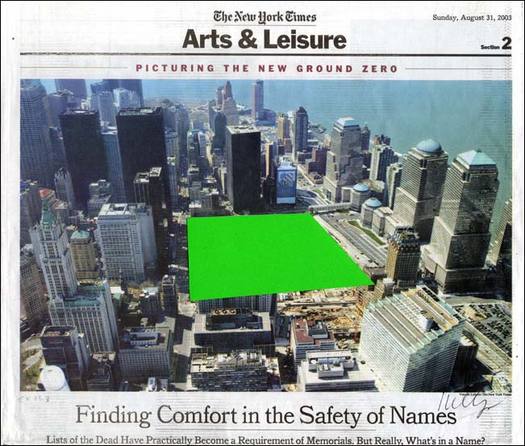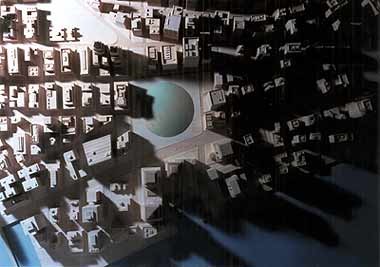
Ground Zero, Ellsworth Kelly, 2003, collage. image:nytimes.com
The reconstructed text of a letter from Ellsworth Kelly to the
Times‘ architecture critic, Herbert Muschamp:
“On October 19, 2001, I wrote a letter to you (that I never sent) in response to an article in The New York Times which discussed the controversy of what was to be planned for the `Ground Zero’ space, asking artists and others for their opinions. (Two artists, Joel Shapiro and John Baldessari urged that no building be erected at the site,and the architect Tadao Ando made a similar proposition.)
“At that time, my idea for the World Trade Center site was a large green mound of grass. (When I saw the aerial photograph of the site on the cover of the Aug. 31 Arts & Leisure section of the Times, [which accompanied art critic Michael Kimmelman’s article, not Muschamp’s. Go figure. -greg.org]) I was excited to see the site from this vantage point. I was inspired to make a collage of my idea for the space, which I am sending you.
“I feel strongly that what is needed is a ‘visual experience,’ not additional buildings, a museum, a list of names or proposals for a freedom monument. (These are) distractions from a spiritual vision for the site: a vision for the future.”
The collage will go on view at the Whitney, which has a show through November titled “Ellsworth Kelly: Red, Green, Blue,” of work from 1959-65.

Tadao Ando’s proposal, meanwhile, was inspired by a Japanese burial mound.
John Baldessari (via
NYTimes, 9/30/01):
“I don’t think anything should be built. The site should be a park. It’s an insane idea because the site is going to be an office, because the business of America is business.”
I can’t find Joel Shapiro’s idea online, but this year, Joel Shapiro collaborated with
Vinci Hamp Architects on a WTC Memorial proposal.








